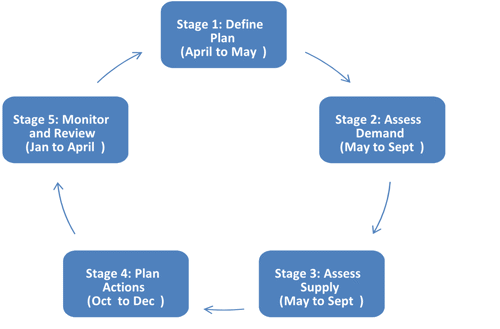Introduction
Page updated: 02/12/2025
This page highlights tools to assist with the distinct stages of workforce and succession planning. It has been developed for Heads of Service and their management teams to help identify priorities and key actions for their service to respond to future workforce risks.
We talk about workforce planning and strategic workforce planning interchangeably. The difference between workforce planning and strategic workforce planning is that they are conducted over different periods of time.
- Workforce planning focuses on your current people resource and operational plans for the budget year ahead.
- Strategic workforce planning looks towards a three- to five-year time horizon.
Always consider which period is most relevant for you as it will allow for better application of the tools on this page.
Workforce planning is a continual process led by each Head of Service, owned by the whole organisation, and enabled by People Management. By analysing your current workforce and determining your future workforce needs, you are identifying the gap between the workforce you have now and your future needs. Then you can implement the right solutions so your division and department can achieve its strategic plans.
Strategic Workforce Planning should be aligned and integrated with other key planning activities i.e., business, and financial planning. Heads of Service are expected to detail what the changes to services will mean for the workforce over that planning period and the actions that are being taken to respond to these.
These key planning activities would normally start around April to June, in preparation for the business planning cycle that starts in September and be completed and reviewed in readiness for the beginning of the budget year.
Strategic Workforce Planning is a continuous, dynamic activity and it is imperative to ensure that within service areas appropriate mechanisms are in place to monitor the action plan and revise as frequently as necessary.

How does workforce planning help?
Workforce planning helps you to identify business problems, the workforce implications and translate them into solutions. It is not about creating plans or filling templates. It is about identifying and developing the right workforce to deliver your service delivery goals.
- The benefits of a planned approach to workforce planning will enable you to:
- ensure talent is available when you need it.
- prepare for the future by anticipating and planning for change.
- become more agile and align with your strategic priorities.
- mitigate current and future workforce-related risks.
HR
Behaviour and Standards
Domestic Abuse and Sexual Violence
- Supporting Victims or Survivors
- Guidance for Managers
- Guidance for Colleagues
- Asking Difficult Questions
- Perpetrator
- Help and Support
Employee relations
- Capability
- Disciplinary
- Grievance
- Investigations
- Collective disputes
- Suspension
- Disciplinary Policy and Procedure Guidance Chief Officer
Employee Support
Equality & Diversity
Flexible Working and Job Share
- FAQ's for employees
- Flexible Working FAQ's for managers
- Flexible Working Policy
- Job Sharing Policy and Procedure - September 2020
Jobs & Careers
Leave and absence
- Adoption & Surrogacy Leave
- Annual Leave
- Career Break
- Compassionate Leave
- Disruptions to working arrangements
- Flexi-time
- Maternity Leave
- Parental Leave
- Paternity Leave
- Purchase of Additional Annual Leave
- Shared Parental Leave
- Time off for dependants
- Unpaid leave
- Neonatal Care Leave & Pay Policy - April 2025
Leaving the council
Directory
Pay & benefits
- Childcare voucher scheme
- Eye tests
- Health Care Plans
- Pay
- Pension Scheme
- Salary Finance
- Travel and Subsistence Policy
Recruiting an Agency Worker
Recruitment
ResourceLink / MyView
Restructuring
Sickness Absence
- Recording Absence
- Return to Work Interviews
- Phased Return to Work
- Attendance Management Meetings
- The Stages of Sickness Absence
- Occupational Health
- Occupational Health Referrals
- Occupational Sick Pay
- Case Conferences
- Reasonable Adjustments (Disability)
- Ill Health Retirement
- Ill Health Retirement - Non Teachers
- Ill Health Retirement - Teachers
- Related Absence
- Sickness & annual leave
- Managing respiratory tract infections including Covid
- FAQ's for employees
- Sickness Absence Policy
Volunteering
Whistleblowing
Workforce and succession planning
More from HR
